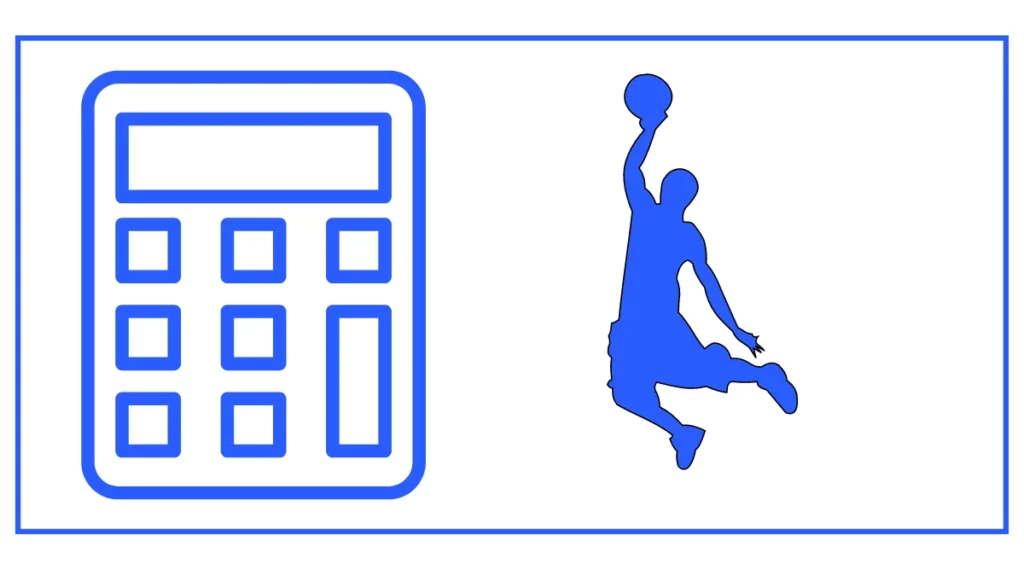True Shooting Calculator (TS percentage)
Are you a basketball player?
Do you want to find out your effieicney at shooting the ball?
The true shooting calculator allows you to calculate the true shooting percentage. All you need to provide is Field Goal Attempts (FGA), Free Throw Attempts (FTA), and the number of points.

You might want to calculate your Aneroabic capacity.
What is True Shooting Percentage?
True shooting percentage is an advanced basketball statistic that provides a more accurate measure of a player’s shooting efficiency than traditional field goal percentage. It considers all types of shots a player attempts, including two-point field goals, three-point field goals, and free throws. This comprehensive approach gives a better picture of a player’s overall scoring ability and efficiency.
The Importance of True Shooting Percentage
True shooting percentage is widely used in basketball analysis because it offers several advantages over other shooting statistics:
- Comprehensive measure: TS% accounts for all types of shots, providing a more complete picture of a player’s scoring efficiency.
- Balances points scored with shooting volume: This statistic considers both the number of points a player scores and the number of shot attempts they take.
- Accounts for free throws: Unlike field goal percentage, TS% factors in free throw attempts, which are an important part of a player’s scoring repertoire.
- Allows for fair comparisons: TS% enables more accurate comparisons between players with different shooting styles or roles on their teams.
How to Calculate True Shooting Percentage
The formula for calculating true shooting percentage is:
TS% = Points / (2 * (Field Goal Attempts + 0.44 * Free Throw Attempts)) * 100
Let’s break down each component of this formula:
- Points: The total number of points scored by the player
- Field Goal Attempts (FGA): The total number of field goals attempted by the player
- Free Throw Attempts (FTA): The total number of free throws attempted by the player
- 0.44: A coefficient that accounts for and-one situations and technical free throws
To calculate TS%, follow these steps:
- Multiply the player’s free throw attempts by 0.44
- Add the result to the player’s field goal attempts
- Multiply this sum by 2
- Divide the player’s total points by the result from step 3
- Multiply by 100 to get the percentage
True Shooting Percentage Calculator
To make it easier to calculate true shooting percentage, you can use the calculator provided above. Simply input the player’s points, field goal attempts, and free throw attempts, and the calculator will determine their true shooting percentage.
Interpreting True Shooting Percentage
Understanding what constitutes a good true shooting percentage is essential for evaluating player performance. Here’s a general guide:
- Excellent: 60% or higher
- Very Good: 57-59%
- Above Average: 54-56%
- Average: 52-53%
- Below Average: 50-51%
- Poor: Below 50%
Keep in mind that these benchmarks can vary depending on the level of play (e.g., high school, college, or professional) and the player’s position.
True Shooting Percentage vs. Traditional Field Goal Percentage
While traditional field goal percentage is still a useful statistic, true shooting percentage offers several advantages:
- Includes free throws: TS% factors in free throw attempts, which are not considered in field goal percentage.
- Accounts for three-pointers: TS% gives appropriate weight to three-point shots, which are worth more points than two-point shots.
- More accurate efficiency measure: By considering all types of shots, TS% provides a more comprehensive view of a player’s scoring efficiency.
Applications of True Shooting Percentage in Basketball Analysis
True shooting percentage has numerous applications in basketball analysis:
- Player evaluation: Scouts and coaches use TS% to assess a player’s scoring efficiency and overall offensive impact.
- Team strategy: TS% can help teams identify their most efficient scorers and adjust their offensive strategies accordingly.
- Player development: By tracking TS% over time, coaches can monitor a player’s improvement in shooting efficiency.
- Lineup analysis: Teams can use TS% to evaluate the effectiveness of different player combinations on the court.
- Contract negotiations: TS% can be a factor in determining a player’s value during contract discussions.
Limitations of True Shooting Percentage
While true shooting percentage is a valuable statistic, it’s important to understand its limitations:
- Doesn’t account for shot difficulty: TS% treats all shots equally, regardless of whether they were contested or wide-open.
- Doesn’t consider playmaking: TS% focuses solely on scoring and doesn’t reflect a player’s ability to create shots for teammates.
- Can be skewed by low volume: Players with very few shot attempts may have unusually high or low TS% that doesn’t accurately reflect their true shooting ability.
- Doesn’t account for game context: TS% doesn’t consider factors like clutch performance or the score of the game when shots were taken.
True Shooting Percentage in Professional Basketball
In the NBA and other professional basketball leagues, true shooting percentage is widely used to evaluate player performance. Many of the league’s top scorers also boast high true shooting percentages, demonstrating their ability to score efficiently.
Some examples of players known for their high true shooting percentages in recent NBA seasons include:
- Stephen Curry
- Kevin Durant
- Giannis Antetokounmpo
- Nikola Jokic
These players combine high scoring volume with excellent efficiency, making them some of the most valuable offensive players in the league.
Improving True Shooting Percentage
For players looking to improve their true shooting percentage, consider the following strategies:
- Shot selection: Focus on taking high-percentage shots and avoiding low-efficiency attempts.
- Three-point shooting: Develop a consistent three-point shot, as these are worth more points and can significantly boost TS%.
- Free throw practice: Improve free throw shooting, as these are uncontested shots that can greatly impact TS%.
- Finishing at the rim: Work on converting close-range shots, which typically have a higher success rate.
- Off-ball movement: Learn to create open shot opportunities through effective off-ball movement.
Conclusion
True shooting percentage is a valuable tool for evaluating a basketball player’s scoring efficiency. By taking into account all types of shots and providing a comprehensive measure of shooting effectiveness, TS% offers insights that traditional statistics like field goal percentage cannot. Whether you’re a coach, analyst, or fan, understanding and utilizing true shooting percentage can enhance your appreciation and analysis of basketball performance.
Remember to use the true shooting percentage calculator provided above to quickly determine a player’s TS%. This tool can be invaluable for on-the-spot analysis and player comparisons. As you continue to explore basketball statistics, keep in mind that while TS% is an important metric, it should be considered alongside other statistics and contextual factors to get a complete picture of a player’s value and performance on the court.





